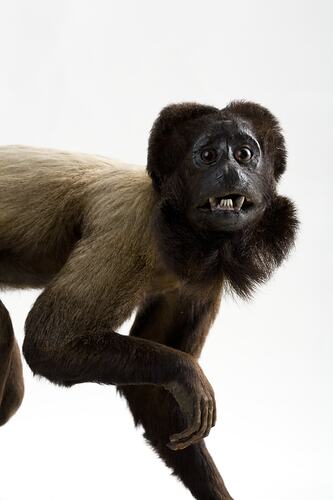Summary
Black Bearded Saki are one of five species of bearded saki, a group of New World monkeys. This species has a very restricted range within the forests of eastern Amazonia in Brazil.
This specimen was donated to the museum after it died in a menagerie, probably in the 1850s. Exactly where it originally came from is unknown. The original collection location is given only as "Guyana" which at the time may have referred to the area which now includes Guyana, Suriname, French Guiana and parts of Brazil, Colombia and Venezuela.
Black Bearded Saki live in communal groups of up to 40 individuals who all forage together. They largely eat immature fruit seeds and have specialised teeth to allow them to open very hard fruits to reach them.
Populations of Black Bearded Saki have declined by over 80% since the 1970s. This has been largely due to habitat destruction for increasing agriculture, cattle ranching, road building and logging. These threats are only likely to continue and escalate in the future as they live in an area densely inhabited by humans. The International Union for Conservation of Nature (IUCN) therefore lists the Black Bearded Saki as Critically Endangered. They are also listed in Appendix II of the Convention on International Trade in Endangered Species (CITES) to ensure that international trade does not threaten their survival in the wild.
Specimen Details
-
Taxon Name
-
Author and date of publication
(Hoffmannsegg, 1807)
-
Preferred Common name
Black Bearded Saki
-
Other Common Names
Brown-bearded Saki
-
Number Of Specimens
1
-
Sex
Unknown
-
Specimen Nature
Nature: Mount, Form: Dry
-
Collected By
Unknown
-
Category
-
Scientific Group
-
Discipline
-
Collecting Areas
-
Type of Item
Taxonomy
-
Kingdom
-
Phylum
-
Subphylum
-
Class
-
Order
-
Suborder
-
Infraorder
-
Family
-
Subfamily
-
Genus
-
Species Name
satanas
Geospatial Information
-
Country







